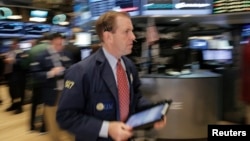The S&P 500 made a stunning comeback going into trading Friday morning, rallying more than 150 points from the Feb. 11 low of 1,810, as the energy and financial sectors finally showed some participation. All three indices closed green for the week.
Even with the tremendous performance, the S&P 500, Dow Jones Industrial Average and Nasdaq are down 4.4%, 4.1% and 8.3%, respectively, year-to-day. This leaves traders wondering if the bottom is now in the market.
"We hit some key technical barriers when the S&P 500 broke through 1,950 on Thursday," Mark Sebastian, COO of Option Pit, said. "Fundamentally, not much has changed with crude oil, but perhaps the perception has. Even if oil were to move lower, there seems to be less panic, especially as the correlation between the stock market and oil breaking down."
Sebastian also believes a new range in the S&P 500 has been established.
"Key levels I am looking at are 1,930-2,000 on the S&P 500 index,” he said. “A move to 1,930 or lower is where I am looking to add fresh buys and would be a seller if the index approaches 1,975-2,000."
Gold also saw strength, although it gave back some gains going into the market close Friday.
Eric Zuccarelli, Independent Metals Trader on the trading floor of the New York Mercantile Exchange (NYMEX), says gold could continue to see some downward pressure.
"With global markets in correction territory at the start of the year, gold found its resistance level at $1,250 an ounce,” he said. “Now that it is less likely the Federal Reserve will raise interest rates and with a better-than-expected Gross Domestic Product [GDP] reading, gold may slip back a bit."
Another bright spot has been in the copper market as the "red metal" broke through key resistance levels at $2.12-$2.15.
"After the Chinese New Year, traders have seen material outflows from the London Metals Exchange [LME], the world's largest market in options and futures for metals, meaning there is tightness in the market place,” Zuccarelli said. “It seems that plans for China to buy copper for smelters and stockpile are beginning to take effect in both price and demand."
What's on tap
The consumer is once again in focus on the earnings calendar with key companies such as AutoZone (AZO), Dollar Tree (DLTR), Ross Stores (ROST) and Costco (COST) due to report quarterly results.
In addition, monthly auto sales figures will be released throughout the day Tuesday. Even though consumers have some extra buying power due to lower prices at the pump, they have been very selective in terms of where they spend that money.
Retailers TJX Companies (TJX), Home Depot (HD) and Lowe's (LOW) reported fantastic earnings, suggesting the consumer is allocating discretionary spending to the discounters and home improvement-related companies. Another area in the consumer discretionary sub-sector that has outperformed is athleisure apparel — leisure clothes that look like athletic apparel.
The economic calendar is what will really drive headlines and market action as the key piece of data, the Non-Farm Payrolls report, is released Friday morning. The employment data give the most comprehensive report on how many people are looking for jobs, how many have them, what they're getting paid and how many hours they are working.
These numbers are the best way to gauge the current state, as well as the future direction, of the economy. Most importantly, it is a major factor the Federal Reserve considers when evaluating economic policy, including interest rate increases and decreases.
Other key data include Pending Home Sales, PMI Manufacturing Index, Construction Spending, API and EIA Crude Oil and Natural Gas Inventories and Jobless Claims.








